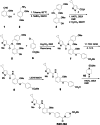A viral assembly inhibitor blocks SARS-CoV-2 replication in airway epithelial cells
- PMID: 38649430
- PMCID: PMC11035691
- DOI: 10.1038/s42003-024-06130-8
A viral assembly inhibitor blocks SARS-CoV-2 replication in airway epithelial cells
Abstract
The ongoing evolution of SARS-CoV-2 to evade vaccines and therapeutics underlines the need for innovative therapies with high genetic barriers to resistance. Therefore, there is pronounced interest in identifying new pharmacological targets in the SARS-CoV-2 viral life cycle. The small molecule PAV-104, identified through a cell-free protein synthesis and assembly screen, was recently shown to target host protein assembly machinery in a manner specific to viral assembly. In this study, we investigate the capacity of PAV-104 to inhibit SARS-CoV-2 replication in human airway epithelial cells (AECs). We show that PAV-104 inhibits >99% of infection with diverse SARS-CoV-2 variants in immortalized AECs, and in primary human AECs cultured at the air-liquid interface (ALI) to represent the lung microenvironment in vivo. Our data demonstrate that PAV-104 inhibits SARS-CoV-2 production without affecting viral entry, mRNA transcription, or protein synthesis. PAV-104 interacts with SARS-CoV-2 nucleocapsid (N) and interferes with its oligomerization, blocking particle assembly. Transcriptomic analysis reveals that PAV-104 reverses SARS-CoV-2 induction of the type-I interferon response and the maturation of nucleoprotein signaling pathway known to support coronavirus replication. Our findings suggest that PAV-104 is a promising therapeutic candidate for COVID-19 with a mechanism of action that is distinct from existing clinical management approaches.
© 2024. The Author(s).
Conflict of interest statement
S.S., A.F.L., M.M., S.F.Y. and K.P. are employees of Prosetta Biosciences. V.R.L. is the CEO of Prosetta Biosciences, which manufactures PAV-104 presented in the manuscript. All other authors declare no competing interests.
Figures









Update of
-
A Novel Viral Assembly Inhibitor Blocks SARS-CoV-2 Replication in Airway Epithelial Cells.Res Sq [Preprint]. 2023 May 17:rs.3.rs-2887435. doi: 10.21203/rs.3.rs-2887435/v1. Res Sq. 2023. Update in: Commun Biol. 2024 Apr 22;7(1):486. doi: 10.1038/s42003-024-06130-8. PMID: 37292622 Free PMC article. Updated. Preprint.
Similar articles
-
A Novel Viral Assembly Inhibitor Blocks SARS-CoV-2 Replication in Airway Epithelial Cells.Res Sq [Preprint]. 2023 May 17:rs.3.rs-2887435. doi: 10.21203/rs.3.rs-2887435/v1. Res Sq. 2023. Update in: Commun Biol. 2024 Apr 22;7(1):486. doi: 10.1038/s42003-024-06130-8. PMID: 37292622 Free PMC article. Updated. Preprint.
-
Resveratrol and Pterostilbene Inhibit SARS-CoV-2 Replication in Air-Liquid Interface Cultured Human Primary Bronchial Epithelial Cells.Viruses. 2021 Jul 10;13(7):1335. doi: 10.3390/v13071335. Viruses. 2021. PMID: 34372541 Free PMC article.
-
Human galectin-9 potently enhances SARS-CoV-2 replication and inflammation in airway epithelial cells.J Mol Cell Biol. 2023 Aug 3;15(4):mjad030. doi: 10.1093/jmcb/mjad030. J Mol Cell Biol. 2023. PMID: 37127426 Free PMC article.
-
Understanding Severe Acute Respiratory Syndrome Coronavirus 2 Replication to Design Efficient Drug Combination Therapies.Intervirology. 2020;63(1-6):2-9. doi: 10.1159/000512141. Epub 2020 Oct 23. Intervirology. 2020. PMID: 33099545 Free PMC article. Review.
-
Understanding Individual SARS-CoV-2 Proteins for Targeted Drug Development against COVID-19.Mol Cell Biol. 2021 Aug 24;41(9):e0018521. doi: 10.1128/MCB.00185-21. Epub 2021 Aug 24. Mol Cell Biol. 2021. PMID: 34124934 Free PMC article. Review.
Cited by
-
SARS-CoV-2 Omicron variations reveal mechanisms controlling cell entry dynamics and antibody neutralization.PLoS Pathog. 2024 Dec 2;20(12):e1012757. doi: 10.1371/journal.ppat.1012757. eCollection 2024 Dec. PLoS Pathog. 2024. PMID: 39621785 Free PMC article.
-
MMPred: a tool to predict peptide mimicry events in MHC class II recognition.Front Genet. 2024 Dec 10;15:1500684. doi: 10.3389/fgene.2024.1500684. eCollection 2024. Front Genet. 2024. PMID: 39722794 Free PMC article.
-
SARS-CoV-2 Assembly: Gaining Infectivity and Beyond.Viruses. 2024 Oct 22;16(11):1648. doi: 10.3390/v16111648. Viruses. 2024. PMID: 39599763 Free PMC article. Review.
-
Small molecule protein assembly modulators with pan-cancer therapeutic efficacy.Open Biol. 2024 Dec;14(12):240210. doi: 10.1098/rsob.240210. Epub 2024 Dec 18. Open Biol. 2024. PMID: 39689856 Free PMC article.
-
A pan-respiratory antiviral chemotype targeting a transient host multi-protein complex.Open Biol. 2024 Jun;14(6):230363. doi: 10.1098/rsob.230363. Epub 2024 Jun 19. Open Biol. 2024. PMID: 38889796 Free PMC article.
References
Publication types
MeSH terms
Substances
Supplementary concepts
Grants and funding
LinkOut - more resources
Full Text Sources
Molecular Biology Databases
Research Materials
Miscellaneous

